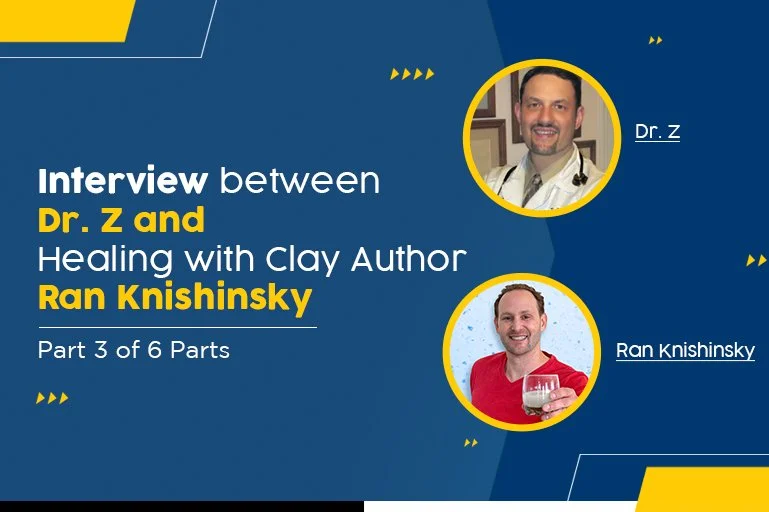Part THREE: Interview between Dr. Z and Healing with Clay Author Ran Knishinsky
This is PART THREE of a SIX PART Interview series.
Dr. Eugene Zampieron, ND interviewed Ran Knishinsky, author of Healing with Clay: A Practical Guide to Earth’s Oldest Natural Remedy about the health benefits of edible clay.
RK: Clay are minerals, and they form the clay structure. They type of mineral clay predicts how it will perform in the body. There are clays that are high in lead or high in iron – so that is why it’s important to know what you’re taking and make sure that if they are present, are in negligible amounts. Arsenic is in so many of the foods that we consume daily from shellfish to mussels, even inside apple seeds. But we’re not dying if we eat an apple or shellfish. So, it’s important that its only there in the smallest of amounts.
Dr. Z: And rice too!
RK: Which is one of my favorite foods.
Dr. Z: Rice and organic rice seem to have high levels of arsenic, which I found mind-blowing. So, clay is extremely important, and we went through types of clay. So how does it detoxify? You mentioned some physics there. Can you go slower with the listeners? What’s creating the binding effect?
RK: Yea, so this is the fun part of understanding clay. This is where science meets, you know, ethno-medicinal treatment. So, for years it was used as a treatment of detoxification, but nobody really understood how profound the action was inside the body. But today thanks to scientific validation, we can understand how clay works, it’s no longer a mystery. It’s no longer a weird sort of explanation. What happens with clay, to understand what clay is, they are small particles, and the way that they are shaped allows for the absorption and adsorption of toxins, and I will explain those two words in a second. Basically, imagine if clay were a peanut butter and jelly sandwich. The bread will attract that toxins that adhere to the outside of the bread, the absorption will draw toxins to the inside of the bread where the peanut butter and jelly are. So, in essence you have toxins drawn to the inside of the clay sphere and to the outside. How that works is through a process called cationic exchange. The negatively charged particles, minerals, that are part of the clay swap out with the positively charged toxins which are in the GI. In doing this, clay absorbs those toxins and holds them. They are released from the body with the feces.
Dr. Z: So, would it be prudent not to take other minerals or your drugs with clay? I remember reading that clay and other potential fibers, and tannins in tea, are contraindicated when you are taking certain medications or dietary supplements – particularly if you want a full range of your GI system to absorb these things. I assume that they can interfere and is there a particular time that you want to take the clay?
RK: That’s a great question. Clay is agnostic. It almost doesn’t care what it is adhering to. It’s very important to choose the right clays. Montmorillonite clay which is really the focus of my book and what I eat on a daily basis has been shown to absorb a few different drugs. They have shown this in clinical studies. So, it’s important when someone is taking a pharmaceutical drug not to take this when they are taking clay. Clay has been shown, in some of the newer research around obesity, to attract fat droplets and literally soak them up. And absorb them into its particle structure. What is fascinating about this is that it prevents those same fat droplets from being absorbed by the body and ensuring that the fats pass through the digestive system. So, with respect to clays and taking vitamins and nutritionals, certain clays leech. The clay that I take and retail at www.detoxdirt.com has been shown to not interfere with the bio-absorption of your natural foods. One thing I do want to point out. It’s one thing to buy a pharmaceutical grade clay like Detox Dirt and its another thing to go online and buy a clay in some part of the world that you are not familiar with – where there has been no mineral assay, no clinical studies, and you’re really not sure how it works or what it contains, there could be a risk if its consumed.
Dr. Z: With our non-commercial bent on the show, we are careful that we don’t promote brands. Now let’s talk a little about how fast clay goes through your digestive tract. Is it different for different people. I know when people have diarrhea clay has been shown to slow things down. What happens when folks are suffering from constipation. Will it exacerbate that or will it act like an amphoteric balancing the effect?
RK: As far as diarrhea goes, there has been a lot of studies. Diarrhea has been controlled within 24 hours within consumption of clay. And your other question was about constipation? It’s important to hydrate when doing clay. Because clay is water loving, hydrophilic, it’s important that the individual drinks a lot of water when consuming clay or there might be a risk of constipation.
Dr. Z: Which would then trap the very toxins that the clay might bind. You want to get them out through the Southern hemisphere.
RK: I like the way you said that.
Dr. Z: Thank you.
RK: I’m going to use that.
Dr. Z: Yea, yea. Family radio!
Read PART FOUR: Interview between Dr. Z and Healing with Clay Author Ran Knishinsky or listen here: https://thenaturalnurse.podbean.com/e/the-natural-nurse-and-dr-z-040522/


